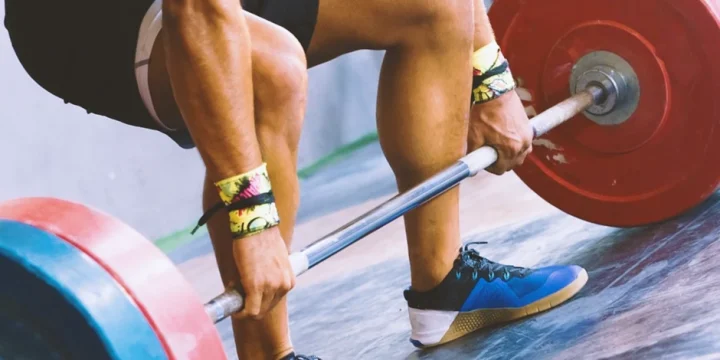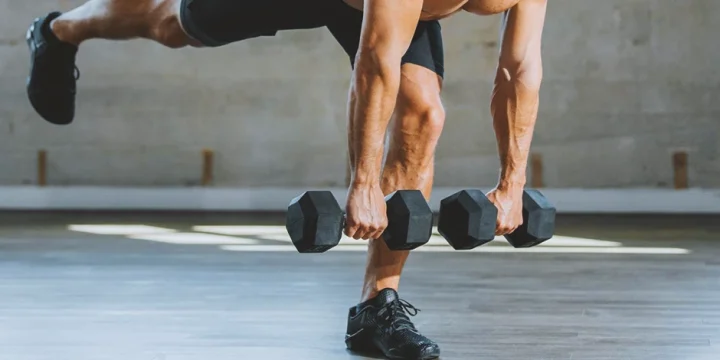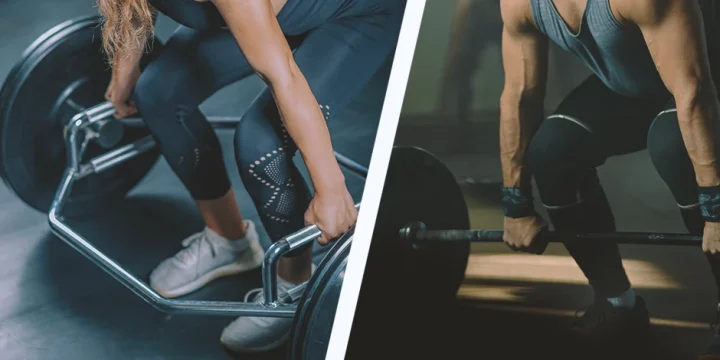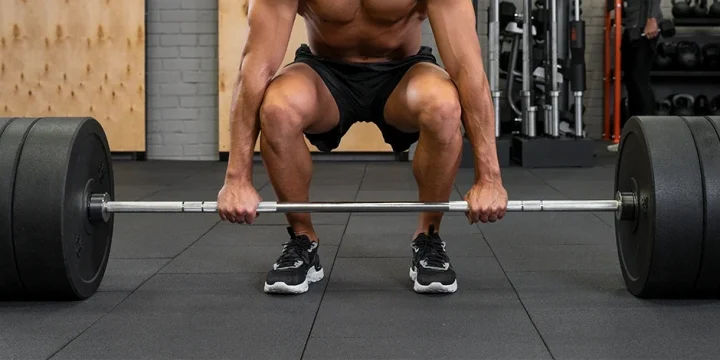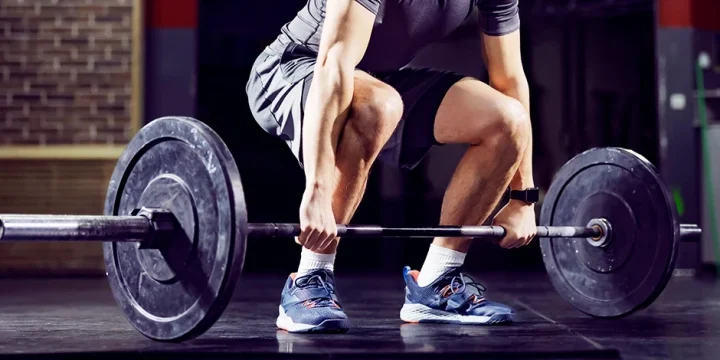The Romanian deadlift (RDL) is a versatile and highly beneficial exercise that targets the posterior chain, including the hamstrings, glutes, and lower back.
As a fitness trainer for over a decade, I have incorporated RDLs into many clients’ fitness plans because they have many benefits, which include building strength and muscle mass, improving overall athletic performance, and preventing injury.
This article will discuss the Romanian deadlift benefits and common mistakes to avoid so you can successfully add the RDL to your workout routine.
Quick Summary
- Romanian deadlift benefits include improving hip flexion, correcting muscle imbalances, increasing hip strength, and building core stability.
- Some of the most common Romanian deadlift mistakes include not keeping your back straight, holding the bar too far away, and starting with weights that are too heavy.
- The Romanian deadlift, like the traditional deadlift, focuses on the posterior chain muscles, including the calves, hamstrings, gluteus maximus, latissimus dorsi, and erector spinae muscles, as per Physio Pedia.
- As a fitness trainer, I always advise clients to do Romanian deadlifts correctly for better strength and muscle growth, emphasizing that avoiding mistakes is crucial for maximizing your gains.
What Are the Benefits of a Romanian Deadlift?
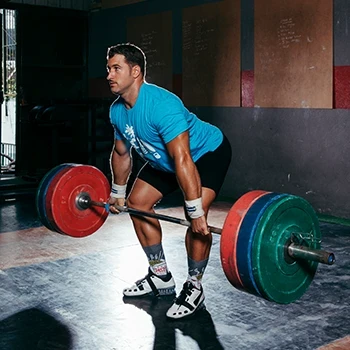
The Romanian deadlift offers a range of benefits, including improved hip flexion, corrected muscle imbalances, increased hip and grip strength, and enhanced core stability.
Particularly effective for refining posture by engaging the lats, core, and reducing shoulder "hunch," this exercise, with its slight knee bend, prioritizes hamstring engagement.
As a fitness trainer, I regularly encourage clients to include Romanian deadlifts in their routines, emphasizing their numerous advantages for overall strength, posture, and muscle engagement, as supported by the National Institute of Health [1].
“Think of the RDL as a dynamic version of the plank. When performed correctly, the deep muscles of the spine work to maintain stability, while the hips allow the movement of flexion and extension.”
- Pete McCall, MS, CSCS
Mistakes To Avoid When Doing Romanian Deadlifts

Avoid these mistakes to ensure proper Romanian deadlift form, reduce injury, and maximize strength gains, as supported by research from PubMed [2].
1. Not Keeping Your Back Flat
Failing to keep your back flat during a Romanian deadlift poses a significant risk: it may cause your back to round, leading to excessive stress on the spine and an increased risk of injury.
Furthermore, not upholding a flat back can compromise the exercise's effectiveness, diminishing its impact on the targeted muscles and potentially causing discomfort or pain.
To avoid this:
In my experience as a fitness trainer, I recommend avoiding going beyond 90 degrees when bending at the hips during a Romanian deadlift.
It's crucial to halt the movement with a flat back and a torso parallel to the floor. I've observed that ensuring a controlled movement with proper form is key to getting the most out of the Romanian deadlift while minimizing potential risk
2. Not Keeping A Neutral Spine
Failing to maintain a neutral spine during a Romanian deadlift increases the risk of back injuries by compromising even load distribution and stressing the spinal column.
This deviation from a neutral spine heightens the chance of spinal flexion, leading to strains, sprains, or more severe injuries.
To avoid this:
I always emphasize to clients the importance of a neutral spine in Romanian deadlifts for a safer and more effective workout. Focus a couple of feet ahead to keep your neck neutral, and be sure to engage your hips, avoiding flexing and extending from the lumbar spine.
3. Keeping The Bar Too Far Away From Your Body
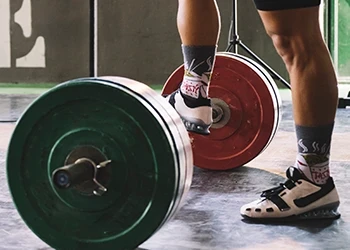
Keeping the bar too far away from your body during a Romanian deadlift may lead to an increased risk of rounding out your back, which places unnecessary stress on the spine and can result in discomfort or injury.
To avoid this:
I consistently advise clients to keep the bar close and to engage their glutes and core, ensuring proper form and minimizing the risk of backrounding in a Romanian deadlift. This dual focus on keeping the bar close and engaging the glutes and core is essential for a successful and injury-free Romanian deadlift.
4. Starting with Heavier Weights
Starting Romanian deadlifts with heavier weights can increase the risk of muscle strain, limited range of motion, and the potential for muscle imbalances. Heavy weights may strain the lower back and hamstrings, jeopardizing proper technique and increasing the likelihood of injury.
To avoid this:
I recommend starting Romanian deadlifts with lighter weights to minimize risks. Emphasizing proper form initially and gradually increasing the load as strength and technique improve has proven to be a safer and more effective approach for progression in this exercise.
Related Articles:
FAQs
What Muscles Does A Romanian Deadlift Work?
The muscles that the Romanian deadlift works include the entire posterior chain, erector spinae, glutes, and hamstrings. Additionally, RDLs engage the adductor magnus, gastrocnemius, trapezius, and forearm flexors.
Should You Bend Your Legs For the RDL?
You should not bend your legs for the RDL like a conventional deadlift or squat. This exercise is a type of stiff-leg deadlift, meaning there should be a subtle, slight bend to the knees.
Push Your Hips and Limits with the Romanian Deadlift
The RDL is a powerful addition to your workout routine, providing numerous benefits.
As you progress in training and experience the rewards of this dynamic exercise, remember that proper nutrition plays a crucial role in maximizing results.
A well-rounded diet, including a high-quality protein powder, aids muscle recovery and growth, ensuring you get the most out of your efforts.
Incorporating one of our tested and approved protein powders into your post-workout regimen will fuel your body with the essential nutrients it needs to reach its full potential.
References:
- https://www.ncbi.nlm.nih.gov/pmc/articles/PMC7046193/
- https://pubmed.ncbi.nlm.nih.gov/11932579/
About The Author
You May Also Like
